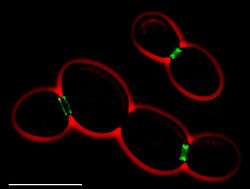Septum (cell biology)
A septum in cell biology is the new cell wall that forms between two daughter cells as a result of cell division.[1]

Septins in Saccharomyces cerevisiae (fluorescent micrograph)
• Green: septins (AgSEP7-GFP)
• Red: cell outline (phase contrast)
• Scale bar: 10 μm
• Green: septins (AgSEP7-GFP)
• Red: cell outline (phase contrast)
• Scale bar: 10 μm
In yeast, septins form a ring structure, to which other proteins are recruited.[2] In particular, chitinase 2 is required, an enzyme that synthesises chitin thereby building up the primary septum. A secondary septum of β-glucans and mannoproteins is then assembled using the enzyme 1,3-Beta-glucan synthase, and the primary septum degraded during cell separation. After degradation of the primary septum, a chitinous bud scar remains on both the mother and daughter cell. [2][3]
References
- O'Connor C (2008). "Cell Division: Stages of Mitosis". Nature Education. 1 (1): 188.
- Cabib E, Roh DH, Schmidt M, Crotti LB, Varma A (June 2001). "The yeast cell wall and septum as paradigms of cell growth and morphogenesis". The Journal of Biological Chemistry. 276 (23): 19679–82. doi:10.1074/jbc.R000031200. PMID 11309404.
- Lesage G, Bussey H (June 2006). "Cell wall assembly in Saccharomyces cerevisiae". Microbiology and Molecular Biology Reviews. 70 (2): 317–43. doi:10.1128/MMBR.00038-05. PMC 1489534. PMID 16760306.
- García Cortés JC, Ramos M, Osumi M, Pérez P, Ribas JC (September 2016). "The Cell Biology of Fission Yeast Septation". Microbiology and Molecular Biology Reviews. 80 (3): 779–91. doi:10.1128/MMBR.00013-16. PMC 4981666. PMID 27466282.
This article is issued from Wikipedia. The text is licensed under Creative Commons - Attribution - Sharealike. Additional terms may apply for the media files.